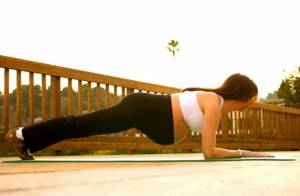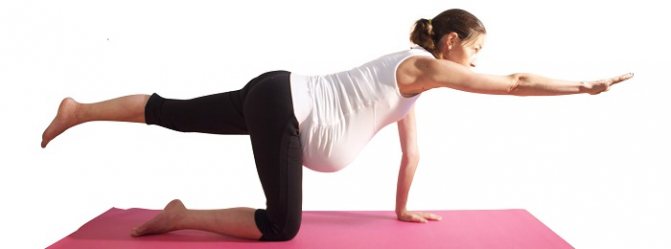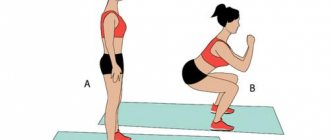Most people are of the opinion that physical activity during pregnancy is contraindicated.
That is why relatives do their best to protect the pregnant woman from any activity. However, expectant mothers who previously led an active lifestyle find it difficult to give up training.
Then they ask doctors if they can play sports, for example, do abs.
Modern gynecologists even encourage physical activity during gestation, the main thing is that the loads are moderate and there are no contraindications.
- Will exercising while carrying a child be harmful?
- Optimal abdominal exercises for pregnant women
- Contraindications
- Experts' opinions
- Olga Panfilova, doctor
- Olga Yakubovskaya, trainer
- Tamara Yakobovna, doctor
- Useful video
- Main conclusions
Will exercising while carrying a child be harmful?

It is not necessary to pump up a pregnant woman’s abs, especially if the girl previously led a passive lifestyle. In this case, it is too late to strengthen the muscles before childbirth, and physical activity can harm the fetus.
But if before conception a woman regularly exercised, then training is not contraindicated.
According to gynecologists, strong abdominal muscles will benefit a pregnant woman. Therefore, they advise regularly training your abs even before conception.
Due to weak abdominal muscles, the expectant mother faces various problems:
- Lower back pain during uterine enlargement.
- Diastasis (divergence) of the rectus muscles in the 3rd trimester of pregnancy.
- Preperitoneal lipoma (hernia in the midline of the abdomen).
- Difficult birth.
- The appearance of stretch marks.
Strong abdominal muscles support an expanding uterus and help avoid stretch marks, as well as lower back pain in later pregnancy. Thanks to trained muscles, efforts during childbirth will be stronger, the fetus will pass through the birth canal faster, and the mother will not be so tired. In addition, it will be easier to regain a thin waist and flat stomach after childbirth.
However, to protect your baby, you need to give preference to lighter workouts.
Not all mothers know whether it is possible to pump up their abs in the early stages of pregnancy. At 2-4 weeks of gestation, the formation of important organs in the fetus occurs, so stress should be avoided. Otherwise, the likelihood of spontaneous abortion increases.
It is better to replace abdominal exercises with special gymnastics or yoga for pregnant women. Regardless of the type of load, a pregnant woman should monitor her well-being. If you experience shortness of breath or increased heart rate, you need to stop and lie down. Expectant mothers are prohibited from doing anything through force.
After approval from your obstetrician/gynecologist, you can incorporate light exercise into your schedule.
Carefully! If you experience discomfort or pain in the lower abdomen, migraines, swelling, discharge, or breathing problems, you should stop exercising and consult a doctor.
In addition, the expectant mother should remember the periods during which she needs to rest both soul and body. Physical activity should be excluded from 12 to 13, from 21 to 23 and at 28 weeks of gestation.
Optimal abdominal exercises for pregnant women

If the gynecologist has allowed the pregnant woman to pump up her abs, then she can start training. These loads differ from standard ones because they are simpler. But despite this, they will help maintain tone and strengthen muscles.
A set of abdominal exercises for expectant mothers:
- Slowly walk in place or in a circle.
- Then, while walking, begin to raise your knees higher one by one for 40 seconds.
- Now make it more difficult to walk by twisting your shins backwards – 20 seconds.
- Stand up, raise one arm above your head, and put the other on your side, tilt your body to the right and left 5-8 times.
- Place your hands on the back of your head, tilt your body forward – 8 times.
- Lie down on a gymnastic mat, bend your knees, place your hands on the back of your head, but do not clasp them. Smoothly raise your head and shoulders. Carefully monitor your feelings if your health worsens, refuse this exercise.
- Do not change your position; one leg remains on the floor, bent at the knee, and place the other on top. Then try to reach the knee with the elbow of the opposite hand - from 5 to 8 times. Then repeat for the other limbs.
- Stay in the same position and slide your legs straight to feel the tension in your abdominal muscles. Then return to the starting position in the same way.
- Turn over on your side, bend the lower limb and straight the upper limb. Raise your leg so that the distance between it and the floor is 8-10 cm. Using the force of the oblique muscles, pull your thigh up and hold for 5 seconds. Perform 10 repetitions.
- Roll over onto your back, place your hands on the sides of your stomach. Start pushing from your stomach, as if someone is lowering you to the floor, then begin to smoothly lift your upper body, overcoming resistance. When you feel tension in your abdomen, hold for 5-10 seconds, then lie down. Repeat 10 times.
- Stand up, press your back against the wall, feet at a distance of 30-40 cm from it. Bend slightly so your hips lean back slightly as you approach the wall, holding for 5 seconds. Perform 8-10 times.
After week 16, give up movements performed while lying on your back. It is better to train your abs while sitting. To do this, sit on the mat, bend your knees, and smoothly lift them towards your chest. Then repeat with straight limbs. Over time, the number of such elements needs to be reduced, replacing them with breathing exercises.
To strengthen your abdominal muscles, you can sit on a chair, and then gently tilt your body back (but not too much), then get up. In the same position you can raise/lower your straight legs.
Pregnant women should remember that they need to train very carefully, move smoothly, and avoid excessive stress and fatigue. Twisting and lifting of the body should not be performed at full amplitude. Exercise should be stopped immediately when minimal discomfort occurs. To lighten the load, you can use a fitball.
#1. Plie
This easy-to-learn exercise will help reduce stress on your knees, back and hips during pregnancy.
Technique: Stand straight, spread your legs wider than your shoulders, bend your knees slightly and spread your feet outward. While taking a deep breath, slowly lower yourself by bending your knees until your thighs are parallel to the floor. Return to the starting position when you feel sufficient tension in the inner thigh muscles. Exhale as you rise from the plie. Try not to fall backward in a deep squat. It is recommended to perform 3 sets of 25 times three times a week, adding, if necessary, 5 squats for progress.
Contraindications

It is prohibited for expectant mothers to train their abs in the following cases:
- Threat of spontaneous abortion.
- Hypertonicity of the uterus.
- The appearance of reddish or brownish discharge.
- Pain in the lower abdomen.
- Toxicosis, which is accompanied by frequent vomiting and exhaustion.
- Presence of complications: incorrect location of the placenta, hypertension, excess amniotic fluid, etc.
It is better to stop exercising if the following symptoms appear:
- Intense headache.
- Increased heart rate.
- Dyspnea.
- There is a tugging in the lower abdomen, or there is pain reminiscent of contractions.
Important! In such cases, training should be stopped, even if the doctor has approved physical activity. In addition, it is worth visiting a doctor who will find out the reason for the appearance of suspicious signs.
You can train your abs only if the process does not cause discomfort and gives pleasure to the expectant mother.
Experts' opinions

Qualified gynecologists advise women to exercise only after the approval of their personal physician. If there are no contraindications, then a woman can perform lighter versions of standard abdominal movements. At the same time, you should constantly monitor your condition. If you experience discomfort in the lower abdomen, headaches, shortness of breath, increased heart rate, or simply fatigue, you should stop training and consult a doctor. If there is no discomfort, and the woman has previously exercised regularly, then exercises for the abdominal muscles will only bring benefits.
However, light physical activity during pregnancy is very beneficial. After regular training, blood flow increases, then the likelihood of stagnation in the vessels of the legs decreases.
In any case, you should consult your personal physician before exercising. If there are no contraindications, the specialist will help the expectant mother choose the safest loads.
The yoga instructor believes that during pregnancy you should even exercise, paying special attention to your abdominal muscles. After all, a strong muscle corset will make pregnancy easier and guarantee a successful birth. However, using standard elements that are usually performed to pump up the press is prohibited!
Effective and simple yoga asanas will help strengthen your abdominal muscles. They definitely won’t harm the baby or mother. Belly dancing will allow the expectant mother to increase her muscle tone. During smooth movements of the hips, swaying, and circles, almost all abdominal muscles are involved in the work. However, before training, a woman should consult with her personal doctor so as not to expose the unborn child and herself to danger.
A qualified obstetrician-gynecologist highlighted the basic rules for abdominal training for pregnant women:
- Modify the exercises depending on the period: the longer it is, the lower the load on the abdominal muscles should be; you should help yourself with your arms and legs.
- Monitor your feelings. If you experience discomfort during exercise, stop immediately, rest, and visit a doctor as soon as possible.
- If you haven't exercised before pregnancy, skip ab workouts or exercise under the supervision of a qualified pregnancy fitness instructor.
And, of course, before conducting classes, consult with your personal gynecologist.
Main conclusions
An expectant mother can train her abs, but under the following conditions:
- After an examination, the doctor approved the initiative of the expectant mother.
- There are no contraindications (toxicosis, threat of miscarriage, hypertension, placenta previa, etc.).
- The pregnant woman feels well, and training brings her pleasure.
- The complex consists of lightweight exercises to improve the tone of the abdominal muscles.
- The load corresponds to the period of pregnancy.
- A woman has not done press exercises on her back since the 2nd trimester.
- The expectant mother regularly exercised even before conception.
In other cases, it is better to refuse training the abdominal muscles in order to protect the child and yourself.
Returning your figure to normal after childbirth is the first item on the wish list of any young mother. A very small percentage of women are unable to fully regain their best form. Basically, anyone can do this with the right approach to the matter. And the first thing you should think about in advance is how to strengthen your abdominal muscles during pregnancy. After all, this is the first condition for achieving an ideal figure shortly after childbirth.
- 80
- 1
- 2
- 3
- 4
- 5
Photo gallery: How to strengthen your abdominal muscles during pregnancy?
Rigid beliefs that women should not move or engage in active sports during pregnancy are long gone. If there are no special contraindications or congenital defects, the mother has no reason not to be active during the entire pregnancy. Moderate and healthy sports for her are the key to an easy recovery after childbirth, and it is also not useless for the child. The abdominal muscle groups are most directly involved in the course and development of pregnancy. And, unfortunately, this is the most problematic area for many women.
Gymnastics during pregnancy helps strengthen the abdominal muscles, maintain good posture, improves blood circulation in the mother's body and reduces the risk of swelling in the limbs and varicose veins.
Also, such activities increase a woman’s self-esteem, help her maintain her tone, prepare for childbirth faster and easier and, mainly, contribute to a faster return to shape in the postpartum period. It is advisable that a woman consult a doctor before starting classes to determine when she can begin or continue training in certain programs. You should also be aware that there are certain conditions during pregnancy that are incompatible with certain sports.
When is exercise not beneficial?
You should not do any work if the following factors exist:
- High blood pressure caused by pregnancy;
- Placental abruption;
- Premature uterine contractions (increased tone);
- Persistent bleeding after 12 weeks;
- Excessive dilatation of the cervix;
- Fetal growth retardation;
- Multiple pregnancy;
- Previous history of miscarriage or premature birth.
Strong abdominals and pregnancy
Don't forget that many active female athletes get pregnant, carry and easily give birth to children without the negative effects of strong abdominal muscles. On the contrary, their good physical shape only helps them, bearing a positive character, since trained muscles make the body flexible and strong, and changes in the abdominal wall are problem-free and easy. That is why the issue of strengthening the abdominal muscles during pregnancy is important for any woman, so that even during pregnancy the tone of the abdominal muscles is maintained at a level. Of course, taking into account the specific circumstances and characteristics of the mother’s body.
Abdominal exercises
In the first four months, do the following exercises:
- Lie on your back and straighten your legs.
- Raise your head and try to touch your chin to your chest.
- Hold this for 3 seconds and return to the starting position.
- Repeat 5 times. Do this exercise twice a day.
Then do the same movement, but stand with your back and leaning on the wall. Keep your abdominal muscles tense. Repeat the exercise 5 times twice a day.
During the period after the first quarter of pregnancy, the following exercises are recommended:
Perform the exercises slowly and concentrated. Listen carefully to your body - even if you feel minimal discomfort, stop exercising.
Long walks are perhaps the most suitable aerobic sport for pregnant women and are highly recommended. Much of yoga turns out to be suitable for expectant mothers as well. Sitting or standing postures, moderate and controlled tension and deep breathing will all cause the abdominal muscles to grow. If a woman engages in active sports before pregnancy, this can only be to her advantage.
If the expectant mother is in good physical shape and if the muscles of her body are toned, the birth process will be easier for her. Therefore, it is advisable to think about the state of your body in advance. But expectant mothers, who before pregnancy led an active lifestyle and played sports, are often concerned about the question of whether it is possible to pump up the abs during pregnancy, and how to do it so as not to harm either themselves or the unborn baby. Let's try to understand this issue.
#5. Kegel exercises
Of course, we hear about these exercises to strengthen the pelvic floor muscles most often, and this is no coincidence - they play an important role in preparing for childbirth and in postpartum recovery
Technique: Imagine that you are using your vaginal muscles to stop the flow of outgoing air. Tighten them and hold them in the contraction position for 5 seconds, then relax for 5 seconds. Perform 10 repetitions with 10 seconds of relaxation between compressions. There is no need to use the muscles of the thighs or buttocks.
Is it possible to pump up abs during pregnancy?
Of course, doing abdominal exercises during pregnancy is not a mandatory procedure. In addition, in some cases these exercises may be contraindicated. Basically, this is possible with certain disorders in the body or with weak physical shape. The exact answer to the question of whether you can pump up your abs during pregnancy or not should be given by a doctor after a thorough examination. You also need to consult a trainer for pregnant women. If a woman was constantly involved in sports before pregnancy, including working out her abs, then she is usually allowed to do this during pregnancy, only in a lighter form.
Physical activity during pregnancy is an important guarantee of giving birth to a strong and healthy baby. It is important that a fitness trainer for pregnant women develop a training program for you, since only he can determine the optimal load that will not be fraught with risks for the child.
For the growth and development of a child, the early stages are the most risky, especially in the second and third weeks of pregnancy. Therefore, during this period it is worth abandoning any loads, since even minimal ones increase the risk of pregnancy failure. Therefore, according to experts, it is not worth pumping up your abs in the early stages of pregnancy.
For a very long time, you should give up any exercises with jumping, exercise bikes, or vibration (such as oriental dancing). The answer to the question of whether you can pump up your abs in the early stages of pregnancy is also rather negative. The best options are yoga and gymnastics, designed specifically for pregnant women. In addition, it is useful to walk in the fresh air at any time.
If the expectant mother has firmly decided to keep her muscles in good shape while carrying the baby, and her doctor does not prohibit light physical activity, then it is still important to remember that active fitness and abdominal exercises should be prohibited. It is also important to take pauses during periods that are critical for the development of the baby in the womb. These are 2-3 weeks of pregnancy, 12-13 weeks, 20-24 weeks and 28 weeks. These days, it is important to avoid any physical activity, and also try not to expose yourself to emotional experiences, so the answer to the question of whether you can pump up your abs during pregnancy will be negative.
In general, light physical activity, including abdominal exercises, is acceptable during late pregnancy. However, if you notice negative symptoms such as swelling, headache, shortness of breath, poor circulation or pain, stop exercising immediately and consult a specialist.
If the expectant mother was involved in sports professionally before pregnancy, then activities such as athletics, gymnastics and yoga can continue during pregnancy. However, the load needs to be reduced, and the selection of shoes and clothing must be taken very responsibly.
Thus, the answer to the question of whether it is possible to pump up abdominal muscles during pregnancy and engage in other types of activity in later stages may be positive, however, you need to approach this carefully, responsibly and carefully.
Abdominal exercises for pregnant women
There are special exercises for pregnant women that help prepare the expectant mother for pregnancy and childbirth. Thanks to these simple recommendations, you can keep your abs toned even during such a difficult period as pregnancy. Up to 16 weeks, you can pump up your abs during pregnancy with the following exercises:
- Slow walking in a circle or in place. You need to keep the right pace and monitor your breathing.
- Walk and raise your knees in front of you. Perform this movement for 30-45 seconds.
- Walk and whip your shin back. Do the exercise for no more than 20 seconds.
- Starting position – feet shoulder-width apart, raise one hand up, keep the other at your waist. Bend to the sides 4-8 times.
- Bend forward. Place your feet shoulder-width apart and place your hands behind your head. Bend forward. When bending over, stretch your arms straight.
- Lie on your back. Please note that pregnant women can pump their abs in this way only when the pregnancy is progressing correctly. Spread your legs bent at the knees, put your hands behind your head and do not close them. Slowly lift your upper body.
- Any breathing exercise will do. This can be deep inhalations and exhalations while lying down.
- Lie on your back. Bend your right leg at the knee and place it on the floor. Place the left one on the right one. Hands should be behind your head. Reach the knees of your left leg with your right elbow, then do the same with your left elbow. Repeat the exercise 5-8 times at a moderate pace.
- Lie on your back, stretch your arms along your body. Bend your knees. Tighten your abdominal muscles and slowly straighten your legs one at a time. Slide them along the floor, then bend your legs in the same way and return them to the starting position.
- Pelvic tilts in a standing position. You need to stand with your back to the wall, put your feet shoulder-width apart, move your heels 30-40 cm from the wall and bend your knees slightly. Tighten your abdominal muscles, tilt your pelvis, moving along the wall. Repeat the exercise 8-10 times.
After the sixteenth week, lying on your back will be difficult and unsafe, so exercises that involve such a position should be excluded. It is better to replace them with exercises in a sitting position. Slowly lift your knees bent and legs straight towards your body. As the period increases, you need to reduce the number of exercises of this kind and switch to breathing exercises.
In the question of how to pump up your abs during pregnancy, a chair will come in handy. You can sit on it and lean back. Feeling the tension in your abdominal muscles, return to the starting position. While sitting on a chair, you can raise and lower your legs. In addition, experts advise using a fitball - it will teach you to relax, which will help during the first contractions.
Women who just want to become mothers in the future are interested in whether it is possible to pump up their abs when planning a pregnancy. Strong abdominal muscles provide good support for a growing uterus. If you've been working out your abs for a long time and then decide to plan a pregnancy, don't give up on it, but slightly reduce the load. During the planning period, it is recommended to practice daily. Keep your workouts short but regular. Also, you don’t need to pump up your abs without preparation, otherwise you may cause back problems. It’s better to consult a trainer who will tell you what load will be optimal for you.
Exercises before pregnancy
For what? Strong and elastic abdominal muscles are not only the key to a flat stomach and thin waist. This is also a guarantee that during pregnancy the growing uterus will receive good support without any additional devices.
What to do? Special exercises to strengthen the abdominal muscles. Yes, it’s boring, it’s difficult, it’s sometimes completely uninteresting - but what is the result!
The main rule is daily training. Let them be short, 15 minutes each, but regular.
The second rule is not to do abdominal exercises (especially in a lying position) without first warming up, so that the useful work does not “backfire” with back problems.
Rule three - change the set of exercises sometimes. First of all, it's more fun. Secondly, the body quickly gets used to both bench presses and crunches, and stops responding to the usual load. That is, if sets of exercises are not alternated, they will quickly cease to be effective.
How to do? The most popular exercise is raising your legs vertically from a lying position. The legs should be straight and the lifts should be slow, without acceleration or lifting the lower back off the floor. The second exercise has been known to us since kindergarten - this is “scissors”. The legs rise and fall alternately, but do not touch the floor. You can also “pump up your abs” by lifting not your legs, but your body while lying down, or you can lift both your legs and your body at the same time. Finally, another position is the twist, in which, while lying down, the left elbow reaches toward the right knee, and the right toward the left. Don’t overload: it’s better to do fewer exercises, but correctly, than a lot, but at the risk of damaging the muscles of the neck and lower back.
Who is contraindicated for physical activity during pregnancy?
It is not always possible to pump up abs while pregnant. Before starting any exercises, you should definitely consult a gynecologist. A specialist will help you select and distribute the load, and will also answer the question of whether you can pump up your abs during pregnancy specifically for you, and whether there are any contraindications for this. The most dangerous factor is the risk of miscarriage. If there is one, then you need to give up physical activity for the entire period of gestation.
Particular caution is needed if there is increased tone of the uterus, pain in the lower abdomen and the presence of bloody discharge. If a specialist strongly recommends giving up exercises, listen to him, let him decide whether pregnant women can pump up their abs in your case. Remember that during pregnancy, exercise aimed at losing weight and increasing muscle tone is strictly contraindicated.
The influence of the press on pregnancy
Of course, a trained abs has only a beneficial effect on the birth process. If the expectant mother exercised regularly before pregnancy, she can control the contraction of the abdominal muscles and follow the correct breathing technique, which will help give birth to a strong and healthy baby easily and without problems.
In addition, after childbirth, stretch marks may appear on the skin. A well-trained abs allows you to prevent them and maintain the beauty of your skin, and then quickly get into shape during childbirth. However, it is important not to overdo it, so that overly pumped muscles do not cause problems. It is important to know how to pump up your abs during pregnancy, and whether you can do it. And to do this, you need to constantly be under the supervision of a professional and listen to your body, remembering that the baby’s health at this time is more important than physical fitness.
Useful habits
For what? Our habits - food and not only - visibly affect the size of the waist and the contours of the abdomen.
What to do? Constant self-control will help you achieve correct posture and a flat stomach - both over what you eat and how you move. It is clear that during pregnancy some points can be revised, taking into account new loads and new requirements.
How to do? Suck your stomach in. By tensing your abs every time you remember to have a royal posture, you automatically train your abdominal muscles. Many tasks in the kitchen and at home can be done while standing rather than sitting - this also helps keep your abs in good shape.
Learn to breathe correctly. The fact is that many women breathe with their chest, and not with their diaphragm (or stomach, like men) - during pregnancy they even have to be retrained. Diaphragmatic breathing will not only help you experience contractions correctly and easily during childbirth, but also strengthens the deep abdominal muscles.
And finally, don't overeat. Instead of fatty and starchy foods (i.e. cakes and fried meats), eat fibrous and fiber-rich foods (i.e. vegetables and fruits). Both your future child and your future flat tummy will thank you for this.
Video instructions on pumping up the abs during pregnancy
- Sports and pregnancy
1.1 Why do you need abs during pregnancy
1.2 Pump up your abs when planning a pregnancy
- Is it possible to pump up abs in the first trimester?
- Is it possible to pump up abs in late pregnancy?
- Abdominal exercises during pregnancy
4.1 What to replace?

Sports and pregnancy
Sports during pregnancy can include yoga, swimming, gymnastics, ball exercises, various sets of exercises for the pelvic floor muscles and abdominal muscles, for example, many people wonder if pregnant women can pump up their abs?
The doctor pays attention to indicators such as:
- Gestational age
- Pregnant woman's well-being
- Fetal condition
- Fetal position
- Test results
It is important to listen to the advice of doctors. It is advisable to avoid some sports altogether. There are alternatives to many sports activities. Training is best done under the supervision of professionals.
Elastic abdominal muscles during pregnancy can help in bearing a child. During childbirth, trained abdominal muscles will help minimize the risk of birth injuries. They will shorten the period of pushing and reduce the risk of ruptures.
A flat tummy before pregnancy will return to its previous shape quickly and with virtually no effort.
When planning a pregnancy, sports will well prepare the body for the load it will have to endure while carrying a child. Swimming, running, and various gymnastic exercises will strengthen the muscles of the back, legs and abdomen. But abdominal exercises should be approached with caution.
When planning a pregnancy, you should pump up your abs only in the first half of the menstrual cycle. Bodybuilding and weightlifting should be completely excluded. All exercises that place excessive physical stress on the abdominal cavity can lead to dysfunction of the female body. They prevent conception and, if it does occur, they can harm the further proper development of the fetus.
#3. Climb
As your belly grows, your center of gravity will change, placing additional stress on your spine and lower back. To relieve stress and minimize discomfort, strengthen your back muscles with this simple exercise.
Technique: spread a soft mat and lie on your stomach. Extend both arms straight out in front of you. The legs must remain motionless. From this position, do 10-15 body lifts, the load can be increased if necessary.
Is it possible to pump up your abs in the first trimester of pregnancy?
When a woman finds out that she will soon become a mother, it is advisable to refrain from any sports activities. Even if a woman has trained intensively, she undoubtedly needs to be careful in the early stages. Before 12 weeks of pregnancy there is a risk of abortion.
Exercising can cause dizziness, nausea, and increase the tone of the uterus. It is even more necessary to refuse pumping up the press. Abdominal stress in early pregnancy can affect:
- Pregnant blood pressure
- T onus of the uterus
- Condition of the digestive tract
Important! Abdominal exercises in the first trimester of pregnancy can cause miscarriage!
Workouts during different periods of pregnancy
In the early stages, serious physical activity is most dangerous, especially in the second and third weeks of pregnancy. At this stage, you should give up any sports activities in order to completely eliminate the risk of miscarriage. Further sports activities in the first trimester are possible.
You should refrain from them if the pregnant woman has severe toxicosis, accompanied by general weakness, frequent vomiting, and low blood pressure.
In the second trimester, the formation of the placenta begins, so you can load the muscles. But after the 16th week you will have to stop doing exercises while lying on your back.

In the second trimester, you should prefer sedentary workouts
As the size of the abdomen increases, training the abs becomes problematic, so the exercises are stopped. At 7–9 months of pregnancy, such exercises can provoke premature birth.
Is it possible to pump up abs in late pregnancy?
Starting from the 28th week of pregnancy, the tummy grows rapidly. Sports activities become problematic and uncomfortable. It is strictly forbidden to pump up the press in the later stages. Abdominal stress can affect the tone of the uterus, thereby causing premature birth.

If a woman has never worked out her abs before pregnancy, then naturally you shouldn’t think about exercising during pregnancy. Of course, pumped up abs, strong and strong abdominal muscles will help you carry your baby and give birth to a healthy child without any problems. After giving birth, your athletic belly will quickly return to its previous shape. Which will make mom very happy. But it is better to exercise before pregnancy. If a woman is at the stage of planning pregnancy, she needs to pump up her abs in the first half of the menstrual cycle.
Inflated abs and childbirth
During contractions, smooth muscles are involved, which the woman is not able to control. In efforts, muscles begin to work, which obey the woman’s consciousness. The muscles of the anterior abdominal wall are also involved. At this point, a strong press will help a lot.
The muscles of the abdominal wall work as an auxiliary motor, and later become the main labor force. The abdominal press works together with the muscles of the uterus to help it.
In women who give birth for the first time, the abdominal muscles are closely adjacent to each other and they have better abs, even without special preparation, than in women who give birth repeatedly.
The abdominal muscles play a decisive role in the last stages of labor. As the baby's head approaches the pelvic outlet, only the strength of the abdominal press will gradually help overcome this last obstacle.
The stronger the abdominal muscles, the easier the entire pregnancy will be, since the load on the body will be distributed evenly. And the birth itself will go faster, because the muscles will help the baby to be born. Strong and inflated abs will help you get your body back into shape much faster after childbirth and get rid of a sagging belly.
During pregnancy, it is strictly forbidden to purposefully pump up your abs. This should have been done before pregnancy.
After a workout at the gym, I pumped up my abs with plates, and I wasn’t limited to just one approach, I loved working out my abs, and one session took up to 30 minutes purely for it and my back. So you can dance Can-Can on my abs))
Now I feel as if the uterus from different sides, now on the right, now on the left, is trying to break out, and it feels as if the muscles are not allowing...
Who had it too? Did your belly start growing later than others?
Girls! Every gynecologist tells me that it will be easy to give birth, that my abdominal muscles are good. Is this a myth or truth? It's just different for everyone. maybe someone knows?
Abdominal exercises during pregnancy
Pool. You can sign up for special swimming courses for pregnant women. The body feels different in water. There are a lot of exercises using various sports and water equipment. The trainer will help you choose the necessary complex that will strengthen your abdominal muscles.
Gymnastic ball. Exercises on a gymnastic ball can be performed even at home. All options for performing gymnastics on a ball can be easily found on the Internet.

Yoga. It's never too late to start yoga classes. It is important that if a woman was not into yoga before pregnancy, then it is better to start with an instructor during pregnancy.
Walking. Regular walks will get your muscles in order. Daily walking at a leisurely pace will not only help avoid pain in muscles and bones during the growth of the abdomen, but will also saturate the body with oxygen. Fresh air is very important for a pregnant woman.








